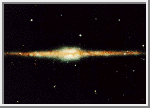|
COMETS EARTH JUPITER KUIPER BELT MARS MERCURY METEORITES NEPTUNE OORT CLOUD PLUTO SATURN SOLAR SYSTEM SPACE SUN URANUS VENUS ORDER PRINTS
PHOTO CATEGORIES SCIENCEVIEWS AMERICAN INDIAN AMPHIBIANS BIRDS BUGS FINE ART FOSSILS THE ISLANDS HISTORICAL PHOTOS MAMMALS OTHER PARKS PLANTS RELIGIOUS REPTILES SCIENCEVIEWS PRINTS
|
Related Document
Download Options
This image of our galaxy, the Milky Way, was taken with NASA's Cosmic Background Explorer (COBE)'s Diffuse Infrared Background Experiment (DIRBE), one of three COBE scientific instruments. This never-before-seen view is a combination of data gathered with DIRBE at intervals within the first six months in orbit and released in April 1990. It shows the Milky Way from an edge-on perspective with the galactic north pole at the top, south pole at the bottom and galactic center at the center. The picture combines images obtained at several near-infrared wavelengths. The dominant source of light at these wavelengths is stars within our galaxy. Even though our solar system is part of the Milky Way, the view looks distant because most of the light comes from the population of stars that are closer to the galactic center than our own Sun. The COBE spacecraft was launched on November 18, 1989, on board the last NASA-owned Delta rocket from Vandenberg Air Force Station, CA. COBE was specifically designed to study the radiation from the Big Bang, believed to be a remnant of the primeval explosion that started the expansion of the universe, and to measure the diffuse infrared and microwave background radiation, which includes the primary remnant of the explosion. |
